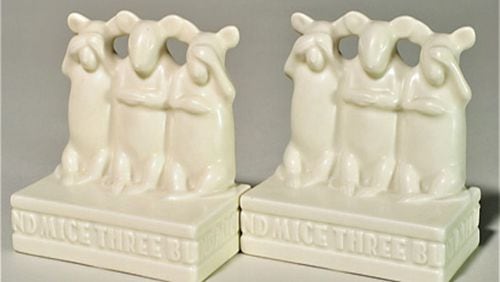Dear Helaine and Joe:
I have been helping my brother clear out his 3,000-square-foot house. Among the items in the library was a set of bookends. They have the Rookwood flame mark and are about 4 inches square. They feature three mice with their eyes covered and the number 6641 underneath along with “See No Evil” on the base. I can’t find anything about them — can you help?
Thank you,
C. B. H.
Dear C. B. H.:
The Rookwood pottery of Cincinnati was a prolific maker of bookends. Among other forms, collectors can find representations of penguins, rooks (crows), owls, horses, panthers, dogs, children reading, girls sitting on benches, sphinxes, ships and so forth.
These rarely bring more than a few hundred dollars at auction, but there are exceptions depending on subject matter, glaze color and condition. Some of the more valuable include seals, ladybugs, double owls, castle gates, double geese, roosters, swans, pelicans and yes, three blind mice, which is what we have in today’s question.
C. B. H. tried to be very good about reporting the marks on the piece, but she left out one of the more important details. Under the flame mark should be a date mark expressed in Roman numerals. In this case, it should be XXVII for 1937.
The piece was created in that year by one of Rookwood’s most famous artists, Kataro Shirayamadani (1865-1948), who first worked at Rookwood from 1887 to 1915 and then again from 1926 to 1948. Shirayamadani is most famous as a painter, but he sculpted this design No. 6641 from which a mold (or molds) was made to produce this rare pair of bookends.
Rookwood was founded in 1880 and is considered by some to be the premier maker of artist-made pottery in the United States. But the firm also made commercial or more mass-produced art wares of which the pair of bookends is an example. Some of their artist-created pieces can bring tens of thousands of dollars each but few of their commercial or production line pieces bring more than a few hundred dollars each.
The Pelicans and the rooster bookends mentioned earlier can sometimes sell for more than $2,000 at auction, but the three blind mice example in today’s question generally sells for as much as $1,500 at auction if their ears have not been repaired. Perfect examples would bring more, and we see the pieces being retailed in the $2,000 to $3,000 range.
At this juncture we want to make the point strongly. People should not clear out houses containing art, antiques and collectibles without professional advice. Without such advice, it would be easy to sell something like this pair of Rookwood bookend for just a few dollars. This happens all the time, but it is not in the best interest of the owner.
One last word of caution: Never, never, never sell anything to the person giving the advice mentioned above or the person pricing your possessions. It is unethical for such persons to buy, and owners would be very unwise to sell to such individuals. But it happens all the time.
———
Helaine Fendelman and Joe Rosson have written a number of books on antiques. Do you have an item you'd like to know more about? Contact them at Joe Rosson, 2504 Seymour Ave., Knoxville, TN 37917, or email them at treasures@knology.net. If you'd like your question to be considered for their column, please include a high-resolution photo of the subject, which must be in focus, with your inquiry.






